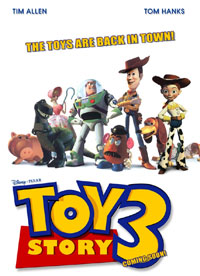
The 15 beats to the Disney Pixar hit are provided by Master Cat! Ben Frahm:
SPOILER ALERT!
1. Opening Image (1):
–We’re reintroduced to all of our favorite characters, Woody, Buzz, and friends, in an action-packed, train-robbery, chase sequence. We’re dropped into this world quickly… and it’s not until after we have some fun and adventure… that we quickly PULL BACK and:
–Realize… we’re remembering a PLAY EPISODE that Andy had years ago.
REVEAL:
–We’re watching a VCR recording of Andy as a young child… when he loved nothing more than to play with his favorite toys. This nostalgic moment seems like so long ago, and our toy characters long for this attention that they once had.
2. Theme Stated (5):
–Woody tells Buzz that they belong to Andy and that they will always be his friends. They must go to college with him, and never lose this bond of loyalty and friendship that they have with their owner.
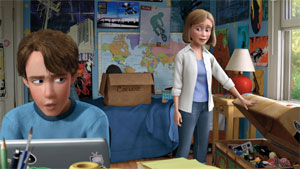
3. Set-Up (1-10):
–Andy is now 17. Andy is going to college. And Andy doesn’t need his toys anymore. In fact, the only way our toys can grab his attention is by pretending to call him on his cell phone, in hopes that he will rediscover them in a toy chest, and play with them like old times.
–Andy is going to college in only a few days, and per his MOTHER’S request, he must organize all of the “old stuff” in his room into piles: 1.) Stuff that should go to the attic in storage; 2.) Stuff that is no longer needed and should be tossed in the garbage; 3.) And lastly, “stuff” that will go to college with Andy in a few days.
–Our toys are panicked. Why doesn’t Andy care about us anymore? Why doesn’t he want to play with us anymore? Will they be tossed aside and forever forgotten? They all hope desperately to be chosen for the college pile, so that they will stay a part of Andy’s life forever.
4. Catalyst (12):
–However, this isn’t exactly the case. There’s a mix up. Andy is cleaning his room and making the various piles that his mother spoke of… when he puts the majority of his toys in a pile meant for the “attic.” This plastic bag is then misinterpreted as junk by Andy’s mother… and taken outside and put by the road to be taken away by the junk man. The toys are devastated. They think Andy’s trying to get rid of them. They are convinced that they mean nothing in Andy’s life. And this is the worst possible case for them. However, we see that Woody was chosen for the college pile, and that he saw Andy put the toys in the attic pile, and thus he knows that Andy still cares about them. Woody must rescue his friends from the junk pile, before they are taken away to the junkyard, never to be seen again.
–Woody to the rescue: Woody jumps out of the window, scales the house, and sees that the GARBAGE TRUCK has just pulled up and is taking away the junk pile. He runs after the truck and tries to stop it, panicked that his friends have been taken away when, looking over, he sees that they’ve escaped to a RECYCLABLE BIN, where they retreat to safety in the garage.
5. Debate (12-25):
–Convinced that they are no longer wanted, the toys find their way into the back of the minivan, into a new pile of belongings… meant for Sunnyside Day Care facility.
–The debate is this: Woody says that Andy didn’t mean to put them in the junk pile and thus still cares about them. All of the other toys don’t believe this, and think that the only way that they can continue to feel loved and be played with by a child is by going to Sunnyside. Woody warns against this: “We belong to Andy. We always have, and this is how it has to be.” But our other toys don’t listen. At least at Sunnyside they will have someone who cares about them and who will play with them on a daily basis… unlike Andy.
–Dramatic questions, posed in the debate: Is Sunnyside a good place? Should toys turn their back on Andy and give up on the idea of going to college with him? Does Andy care about them anymore… and did he really put them in the junk pile?
–These are all questions that FUEL AND PROPEL our second act, as well as the conflict resolution in the third act. They are specific, and hold both emotional and physical stakes to each of our characters.
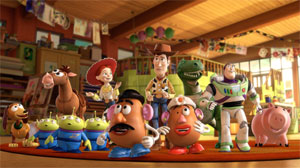
6. Break into Two (25)
–Arrive at Sunnyside Day Care. Despite the warnings of Woody, this place seems pretty good, right? Everybody seems nice enough. There are a lot of new toy friends. Cool facilities. And there are tons of playmates that will give them lots of love and attention… something that Andy is no longer capable of…
–Meet LOTSO, the fuzzy leader of Sunnyside. He’s welcoming and kind, and happy to meet the “new guys.”
–However, something in Woody still doesn’t feel right. He knows that he belongs to Andy, as do all of them, and he tells them again that Andy still cares about them. They of course don’t believe him, still convinced they were put in the junk pile. So, Woody has no other choice… he says goodbye to all of his friends, and sets out on a journey to get back to Andy’s house and make it back into the “college pile” where he will be reunited with his owner.
–(AGAIN: THEME, THEME, THEME: issues of friendship, loyalty, separation, moving on in your life… we see this with the peripheral story lines. The A Story just said goodbye to the B Story… and Woody has left his friends).
7. B Story (30):
–Woody heads out on a journey to get home to Andy. And of course there are complications. He gets stuck in the bathroom. He tries to fly away via the roof. And then gets caught in a tree… and noticed by a LITTLE GIRL, BONNIE, who attends Sunnyside. She is intrigued with Woody and takes him home with her.
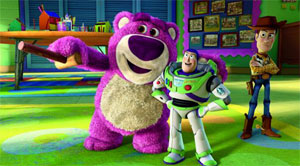
8. Fun and Games (30-55):
–The acclamation of our characters into Sunnyside: there is something new and appealing to this place. Our toys are starting to like it here. This is going to be a lot of fun…
–That is, until the rambunctious PLAYMATES return from recess… and have one KILLER SESSION of intense, rowdy, aggressive play. Our toys are thrust around. Painted with. Smashed against each other. Eyes pulled out. Ears tweaked. They’ve never experienced free play like this before.
–Meanwhile, our B STORY is home with Bonnie, having some fun IMAGINATIVE PLAY in her yard. She’s a caring, kind girl, who comes from a loving family. But Woody still misses his real owner.
–(And note: a good fun ‘n games, always has the back of forth of the A AND B STORIES… as they both propel and forward the plot).
–Nighttime is setting in Sunnyside, and our characters are fully exhausted after a play session from hell. Buzz and friends realize that they’re not in the “age appropriate” Child Care rooms, and go to ask Latso if they can move to an older group, as they’re used to playing with Andy, who’s a lot more mature and considerate.
–However, when they go to find Latso, they see that he’s up to no good. Latso is really an evil character, and plans on holding our toys hostage, as he’s the boss, and ruler of Sunnyside. And MR. KEN BARBIE, the guy who BARBIE met earlier in the second act, who seems like only a gentleman, is really on Latso’s side and is his right hand man.
–Latso and Ken seize BUZZ LIGHT YEAR, and take him to the back, where he is REPROGRAMMED, and his authentic, lovable self is erased. Now Buzz is on Latso’s side.
–But our other toys don’t know this, and get caught up by Latso and Buzz, and locked away, like they’re in Shawshank prison.
CUT BACK TO OUR B STORY:
–Woody is getting ready for bed after a day of play, when he meets some of Bonnie’s other toys. These toys know of Sunnyside. And they warn against the dangers of that place. As well as the evil Mr. Latso… who, we come to learn, has a back-story that has influenced and created him as a monster. You see, Latso feels abandoned by his play owner, and this has created the mistrust and sadness that fuels his anger as an antagonist. (Again, even our BAD GUY, has a story line that deals with friendship, abandonment, loyalty, etc. Michael Arndt, the screenwriter, is a smart dude who really understands how to tell a focused and clean story, thematically).
–Now, Woody knows his friends aren’t safe at Sunnyside. He must return to get them. And help them back to Andy before he leaves to college in a day.
9. Midpoint (55):
–Is the intersection of our A AND B stories: Woody comes back to Sunnyside to rescue his imprisoned friends.
–And it is now… that we are also introduced to a TICKING CLOCK.
–Via Mrs. Potato Head’s missing EYE, that was set-up earlier in the story: her eye was missing and stuck under Andy’s bed… we learn that Andy did NOT in fact want to throw away his toys, but only wanted to put them in the attic pile. And, also, there’s the ticking clock element… where we all see that Andy is now only a day away from going to college.
–This new information allows our characters to feel the need and pressure to get out of there now. And also, allows for them to have emotional closure, and realize that Andy still does care about them.
–Plan: tonight, we have to break out of here.
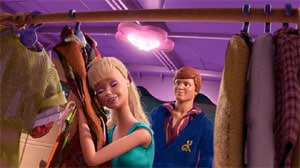
10. Bad Guys Close In (55-75):
–But it’s not going to be easy. Latso has his men everywhere. He has a WANDERING BABY patrolling outside. He has a trained MONKEY watching the video screens. The bad guys are looking pretty tough right now.
–Night comes… and the escape PLAN BEGINS…
–Working together, our friends devise a plan to escape through the JUNK CHUTE, as this is the only way out of Sunnyside.
–All the while, Barbie has a plan of her own. She’s distracting the evil Mr. Ken, and trying to free the BRAINWASHED BUZZ LIGHT YEAR.
–The plan is going well…
Everyone’s working together…
And despite some glitches, it looks like they’re going to make it through the GARBAGE CHUTE… when Latso appears. He’s on to them. He’s caught them. And they will never escape Sunnyside.
–At that moment, the GARBAGE TRUCK comes and empties the CHUTE, carrying away, all of our characters, as well as the evil Mr. Latso.
11. All Is Lost (75):
–Their plan has not only failed but it looks like they’re headed for total disaster… in the back of the garbage truck, with the evil Mr. Latso…
12. Dark Night of the Soul (75-85):
–And if things couldn’t get any worse, our characters are now taken away to the JUNK YARD, and headed right for the JUNK FIRE, as Latso torments and delights in their situation.
–It’s not looking good for anyone at this point.
–Their goal of getting back to Andy will never be a reality…
–And it looks like Latso is going to win… as they’re whisked away into the JUNK YARD FIRE…
–However…
13. Break into Three (85):
–Breaking into the third act, our characters again rally together and use what they’ve learned with each other to defeat Mr. Latso. Woody tells Latso that he was never abandoned and that his owner still cares about him. He knows of his story and he shows him a “ribbon” that Latso’s owner used to give him. Latso is distracted and this allows our characters to escape.
–Latso is taken away by one of the JUNK TRUCK DRIVERS and appears to be a HOOD ORNAMENT on the truck.
14. Finale (85-110):
–Our characters must get home to Andy before he leaves for college…
–And they turn and recognize one of the TRUCK DRIVERS that we saw earlier in the movie… he’s the GUY WHO LISTEN TO HIS iPOD at work, and who, almost took away our characters in the beginning when they were accidentally taken to the garbage pile.
–Our characters know this garbage guy is on Andy’s route, and thus, this is their way home…
–(AGAIN, fantastically CLEAN, and specific, and tight writing from Michael Arndt; everything is a set-up and pay-off!!!!).
–Everyone returns home to find Andy.
–Our characters now realize that Andy still cares about them and that they will be happy in the attic, as they will have each other. Woody returns to his chosen spot in the college pile, and everyone else jumps in the “attic box.”
–However, there’s an EMOTIONAL BEAT here with Andy’s mother. And again, this PERFECTLY ECHOS and reiterates our THEME.
–Andy’s mother is sad that he’s leaving for college. She doesn’t want her beloved son to leave. And she’s having trouble coming to terms with this separation. “I always want to be a part of your life, Andy…” The mother tells him, trying to choke back tears.
–These heartfelt, and inspirational words change something in Woody, who jumps from the college pile. Woody knows that he doesn’t want to be separated from his other friends, and that he must do something quickly to change this.
–Woody jumps on the attic box, and we see him writing something…
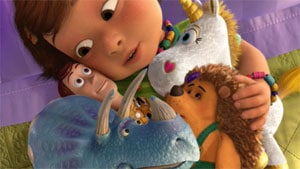
15. Final Image (110):
–It’s Bonnie’s address that Woody just wrote.
–And ALL OF OUR CHARACTERS, still in the box, are scooped up by Andy and taken to…
BONNIE’S HOUSE…
–Where Woody has already been… and he’s seen what a kind, young girl Bonnie is. She lives in a loving family. And she will appreciate them all as toys.
–Andy introduces Bonnie to all of his toys.
–They have a play session together…
–And we know what Bonnie will be in the perfect person to inherit these amazing characters…
–And thus, we’ve come a long way from our opening image. We started our movie, watching Andy, as a young kid, playing with his favorite toys. And now, the BATON has been passed, and we’ve introduced a new life and characters for all of our toys. They will get to stay together. And just as Andy is going off to start a new life, with new friends, our toys will be doing the same…
BJ Markel
27 Comments
Leave a Reply Cancel reply
You must be logged in to post a comment.


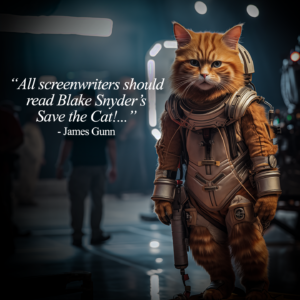






Seems to me that the whole escape from the daycare, followed by the incident at the dump, is the Finale. That’s the big action section where the heroes rally and the bad guys are overcome. It is most certainly not “Bad Guys Close In”, because the good guys are defeating them one after another.
By the time they get back to Andy’s house, everything is denouement, apart from one action taken (Woody writing on the sticky note).
Thanks, DS! Let the conversation begin!!
Ugh. I cried at the movie. I cried reading this. Pixar is very good at triggering emotional responses. The have positively perfect structure, but it doesn’t feel forced, which is likely due to the care that Pixar gives to the story. No other studio is like it. Even Disney doesn’t do what these guys do, maybe in the non-Pixar animation department, but Pixar really is one of a kind.
Why wouldn’t it be bad guys closing in?
If in fact one of the main themes of the movie was to never lose the bond of loyalty and friendship that they have with their owner,
then all that stuff at the garbage chute and the reform of Lotso was the close in maybe?
the good guys were defeating, but the real enemy was not nearly defeated.
sorry
i missed a chunk, i meant that they made the mistake of trusting a toy that was too far gone. when they saved him, all was lost for everyone.
but the dark night
was when they accepted their defeat
i agree that it would be a finale as well. In that case, the climax was the end of the chute, but i felt like it was most definitely an act climax.
THe whole section after felt like a third act to me as well, where the kid friendly climax would be the final moment of separation. THe last toy in the box, he made his choice, but then, there is doubt that they will be together, as andy is unsure.
in that case
i would say the end of the third act, is andy letting go himself.
and the final image being the time lapse as he leaves and the new life the toys have.
Hey all!
Just saw Toy Story 3 and thought “Hey! The storyline of Andy growing up sounds familiar…” so I went to the Toy Story Forum Yahoo group to check it out and I posted the idea for the third film back in January of 2006!
LOL!!! (Gotta learn to keep my ideas to myself!!!)
: )
Angie <– who wrote a script using the STC method which was requested by a producer! Wish me luck!
Now THAT’S how you write a beat sheet! (And how you write a movie, of course — I’m in awe of Michael Arndt.)
Good luck, Angie, way to go. .
I haven’t seen TS 3 yet, but I will definitely feel the presence of the beat sheet master. It’s been about a year since Blake died. Thankfully, his spirit, and his fabulous “beat sheet” are still very much with us, and will continue to grow in influence.
It makes me happy in every instance where I can convey his wisdom, and recommend his books to others. I will go see TS this week for sure.
Thank you Blake!! ))_^^((
Beat sheet makes no sense.
I agree with SM. I think this is an attempt to ram this story into a formula that it doesn’t fit. The BS2 is a great guideline, but not every story follows it to the letter, and TS3 is a perfect example of that.
TOY STORY 3: BAD GUYS CLOSE IN DEBATE:
Thank you all for your comments and thoughts regarding the most recent beat sheet write-up for TS3.
As it seems that there’s concern and criticism for WHERE THE “BAD GUYS CLOSE IN” sequence of this movie happens and what kind of structural significance it has to the rest of the story line, particularly our characters, the A story and goal, and the resolution of our movie…
I thought it might be helpful to further discuss this part of the movie and try to answer some questions that people might be having.
As per the BLAKE SNYDER BEAT SHEET, the “Bad Guys Close In” happens right after the MIDPOINT (pg. 55, about an hour into our movie), where typically the STAKES ARE RAISED, a TICKING CLOCK has just been introduced, and also the INTERSECTION OF THE A AND B STORIES occur.
In TOY STORY 3, some of you argued that our toy characters trying to escape the DAY CARE and fighting the EVIL MR. LATSO, was the “FINALE” of our movie and not the BAD GUYS CLOSE IN… as this is the BIG CLIMAX AND RESOLUTION OF OUR MOVIE… NO?
However, if we look closer, perhaps I can convince you otherwise.
Let’s think about the MAJOR DILEMMA in this story. It’s not Latso, it’s ANDY!!!!!!!! It’s the kid who no longer needs his toys. This is the heart and emotion in this film, and this is the MAJOR AND DRIVING PROBLEM that propels our entire story.
So therefore, our FINALE, in the third act, is the RESOLUTION of Andy and his toys. Latso, late in the second act, is merely an obstacle to achieving this resolution. And yes, if he succeeded, our toys would never find the resolution that they deserve with Andy. However, in stepping back, we know that as soon as our characters find their way home… back to ANDY’S HOUSE…, we know we’re BROKEN INTO THE THIRD ACT. And if you re-watch the movie, you will see that this happens, perfectly on schedule… about 85-90 minutes into the movie.
And thus, our FINALE is the resolution of our A STORY: WHAT WILL HAPPEN TO OUR TOYS IF ANDY GOES TO COLLEGE? This is the ANSWER that we’ve been waiting for the entire time… and this is what our MOVIE’S THEME IS ABOUT: LOYALTY, ABANDONMENT, FRIENDSHIP, and SEPARATION. The resolution of these THEMES and issues is the MAJOR ANSWER that we’ve been waiting for, and as the THIRD ACT is always about SYNTHESIS AND RESOLUTION, this is most definitely the FINALE of our movie.
Okay, you still don’t believe me, and are convinced that LATSO and his crew is indeed the FINALE of this movie. Okay, let’s take a look at that, and talk about how that doesn’t work structurally. If fighting Latso and his characters is the FINALE (which happens in the THIRD ACT, about 100-110 pages in), then that means our movie is done at minute 85. I argue that if DEFEATING MR. LATSO was the FINALE, and the MAJOR RESOLUTION IN OUR MOVIE… then our movie would have ENDED AT THAT POINT. As soon as LATSO was defeated… then FADE OUT. Minute 85… DONE… everybody go home… there’s nothing more to see.
However, we have an entire THIRD ACT, yet to resolve. Again, the BIGGEST AND THE BEST is saved for last. We no longer care about MR. LATSO, we care about ANDY… and whether or not he still cares for his TOYS! THIS IS THE MAJOR RESOLUTION THAT HAPPENS IN OUR THIRD ACT… AND THUS THIS IS THE REAL FINALE, which just so happens to fit perfectly into the TIME SCHEME OF THIS movie… about 105 minutes in… we’re back in Andy’s house, and our CHARACTERS are resolving the MAJOR QUESTIONS AND ISSUES they’ve had this entire TIME!
I also argue that TOY STORY 3 fits absolutely perfectly into BLAKE’S BEAT SHEET. The writing is absolutely clear and structural and I engage all of the readers to ask and argue as much as they can… only to step back and see that such a movie only reaffirms Blake’s Beats. If we watch this movie again with a stopwatch, we will see that the MAJOR ACT BREAKS are perfectly timed to Blake’s beat sheet.
ACT 1, (1-25 minutes): Andy’s home: thesis act: “I don’t feel wanted by my owner.”
ACT 2, (25-85): Sunnyside Day Care: anti-thesis act: the upside-down world of the story, “where our toys are trying to find new owners…”
ACT 3 (85-110): Getting back to Andy’s home: synthesis/resolution act: “Our toys return to their original owner and find the answers that they’ve been looking for this entire time… Andy’s not going to take them to college but he knows of something great who will be their new owner.”
Ben,
Thank you for the follow up explanation of structure in the story. I just went through the 2 day Save The Cat workshop with Jose and seven other very talented writers, and having just seen TS3, absolutely agree with your explanation. Love the class and the BS2 process. I know my story has improved greatly because of BS2, the workshop and feedback from the other writers! I’m getting my story read because I used Blake’s Beat Sheet process. Thank you!
Can you fix the “Latso” references?
Haven’t seen TS3. I’m new to screenwriting plus trying to comprehend it all thru a lyme infested brain, but I’m surprised (maybe even a little disappointed) that Andy’s role in answering the question of whether or not the toys are wanted or not is limited to sorting the toys and taking them to a new owner who will care for them. That’s it! Right. All the rest of the film/story centers on the toys playing out their feelings around the theme? Thanks for this…lots of fun.
As Blake says in STC, BS2 is what any successful movie usually follows. I’ve seen a lot of movies that don’t follow BS2, and most of them belong in a s#1tpile.
One great movie that intentionally defied convention (and BS2) was “No Country for Old Men”.
SPOILER ALERT!
Most people watching the film thought that the protagonist of the piece was Llewelyn Moss (Josh Brolin) — all of the audience identification and tension were invested in him for many reasons, not the least of which was that Moss stood to change more than any other characters in their respective story arcs.
Most audience members thought Anton Chigurh(Javier Bardem) was the antagonist — he does everything he can to cause the audience NOT to identify with him. As a matter of fact, every action he takes is designed to make the audience empathize even more with Moss.
In a deliberate break from movie convention, Moss gets killed, offscreen, 3/4 of the way into the film, not by the supposed antagonist( Chigurh ) but by a gang of guys, to whom none of which we are ever introduced. At this point in the film, the only character we want to follow is Chigurh.
Eventually, the movie ends on an anticlimax.
My problem with NCFOM is that the break from convention is so blatant that it feels like the Coen Brothers (by way of Cormac McCarthy) made the decision to mislead the audience just for the sake of doing so. It felt like a gimmick rather than a creative choice that was made to illuminate the characters or the plot. Further, it smacks of Deus ex Machina in that McCarthy painted himself into a corner with his unbeatable antagonist and just decided to eliminate the protagonist out of hand rather than write the protagonist out of his sticky situation.
Even if the technique was deliberate, it still made the story weaker — the movie feels like it dangles in space without the anchor of a point of view character (Moss).
In spite of the story “problems” the film remains compelling. The audience is still gripped with the tension bound up in the characters who are left standing. We even get a Save the Cat moment at the end when Chigurrh decides to abstain from killing the 2 kids who have seen his face. We think “this psycho isn’t so bad”. Chigurh is so depraved through the whole movie that we normalize somewhat to his behavior. Additionally, we are left feeling so bereft of a clear protagonist that we want to cast Chigurh in the role. We even think of him as “not so bad” by the end of the film just because he DIDN’T murder somebody.
STC is a formalized way of explaining what human beings like to see in their stories.
Personally, I combine STC with a couple of other methods I’ve picked up in other books. Those techniques help me to analyze screenplays (my own and others), and to write and rewrite my own. Together, the techniques provide a template that assists me in seeing, and remembering, so much more in a screenplay than I ever could before.
Drama isn’t a mysterious inscrutable art impenetrable to analysis. There are conventions of drama that people naturally take an interest in. Those conventions persist despite many attempts to defy them. As long as humans exist in their present form (homo sapiens), those conventions will remain interesting to people.
The BS2 is a tool to analyze the elements of drama that specifically apply to the screenplay which, owing to the constraints of the of the medium, is well suited to the analysis of its dramatic elements.
All of this is my long-winded way of saying, “If you don’t have anything useful to say in this forum, stop posting to it. At the minimum, explain what you mean when you say ‘Beat sheet makes no sense.'”
Wonderful breakdown, thank you!
I LOVED Toy Story 3. I haven’t seen a movie work so well in a very long time… likely since Toy Story 2, now that I think about it. Watching it, I remember thinking that the ending with Andy went on for longer than most finale/wrap ups (even though I ate up every single moment), but now that I see it in the beat sheet (along with the extended explanation) I totally see where you’re coming from.
If you have a chance (please, pretty please!) could you break the Finale out into Blake’s “storming the castle” beats? That’s where I always seem to lose my grip.
Thanks again for a fabulous beat sheet!
Great beat sheet! So, does anyone else think the moment when Big Baby turns on Lotso at the garbage chute is a shout-out to Darth Vader turning on the Emperor in Return of the Jedi?
I beleive the theme is “To let Go and move on”. As Blake wrote, the main theme is “Spoken to the main character” (in this case Woody who have to learn to let go). I remember a scene at the beginning where Buzz (or another toy) tells him someting along the line.
The whole film is Woody trying not to let go his human, torn between his friend toys that already moved on and the past.
It is just at the very end when Woody tried everything to get back to the kid, until facing death, that he decide to let go his pursuit and find a new truth, his real friends are the other toys and not the humans. They are the one that saves him too, not the kid (as the bad guy told him, “Where is your kid now?”).
This Toystory 3 analysis is discussed on http://aliendjinnromances.blogspot.com/2010/07/toystory-3-analyzed-for-beats.html
Your Break into Three beat is incorrect.
Woody doesn’t show the ribbon to Lotso there; he does it before they all fall into the dumpster at Sunnyside, during Bad Guys Close In.
In Act Three, the toys help Lotso reach the emergency stop button, but instead of pushing it, he sneers, “Where’s your kid now?” and runs off. Then, after the toys are saved from the fire, Lotso is discovered by the trash collectors and put on their grill.
What this beat sheet calls the FINALE is actually Act III.
Sasquatch is correct about the Lotso chronology.
Also, this is too long to be a Beat Sheet. It’s a good thing to read and makes good points, but would print out to five or so pages. The idea of the Beat Sheet is to keep it short. There were a lot of details in this piece that make it more a synopsis.
I have to say that I agree with James Nolan on this being more of a synopsis than a beat sheet – BUT – I LOVE IT! It is more like a guide on what to write prior to writing your story, right?
Meaning, we should be able to have this type of synopsis written prior to embarking out on writing the story and we will be golden. Thus the index cards and the board, right?
I have just recently read STC and TS3 was actually the first movie I saw after completely swallowing the STC book whole in 2 sittings… I read it like it was coming straight from Ben Kenobi and was immediately in awe of the entire work. I am currently reading Vogler’s Writer’s Journey and and Campbell’s work too – but I think the STC is a more practical TEMPLATE GUIDE on how to actually get a work finished!
As for the TS3 following the guide of the BS2 I have to admit that when I finished reading STC and then watched this movie I was completely draw dropped with how exactly by the beats it was. Folks claiming that this article is trying to smush this structure on to TS3 are just not completely grasping the beats I think.
One philosophical question I had about TS3 particularly though was — In a sequel, when we know who the good guys are, is there necessarily a “save the cat” moment?
I know the beginning adventure scene was awesome and it made us like these toys, but where exactly in this plot line is the save the cat moment? There are so many things Woody does that make you like him do you think the writer just felt like he didn’t need one particular thing to indicate it?
I would think if someone saw TS3 and it was their first TS movie they had ever scene – the introduction sort of lacked that definitive save the cat moment (early on.) Of course, Woody trying to save the toys at the beginning makes him the hero etc.. but I mean that subtle little save the cat moment in the first five pages, right?
I have only scene the movie the one time, so maybe I am forgetting, but I was actually looking for it after having read the book…
In Book of Eli it was so obviously when Denzel fed the little mouse some food — I was looking for that type of thing.
But I thought a Beat Sheet was only supposed to have one or 2 sentences for each beat. It’s supposed to be only ONE page, I thought!
This beat sheet was so amazing it made me see my own script in a whole new way.
If you know how I might get my hands on a copy of the TS 3 script, I’d be forever indebted. I bought what I thought was the script from Script Fly only to find it was a completely different (and much inferior) script by a couple of writers who weren’t Michael Arndt.
Wow…this beatsheet is so good that I shed a tear during the “final image” portion.
I think the second sentence in BREAK INTO THREE: “Woody tells Latso that he was never abandoned and that his owner still cares about him. He knows of his story and he shows him a “ribbon” that Latso’s owner used to give him. Latso is distracted and this allows our characters to escape.” got pushed down from BAD GUYS CLOSE IN, where it should be the second last paragraph. So it’s just in the wrong order chronologically.